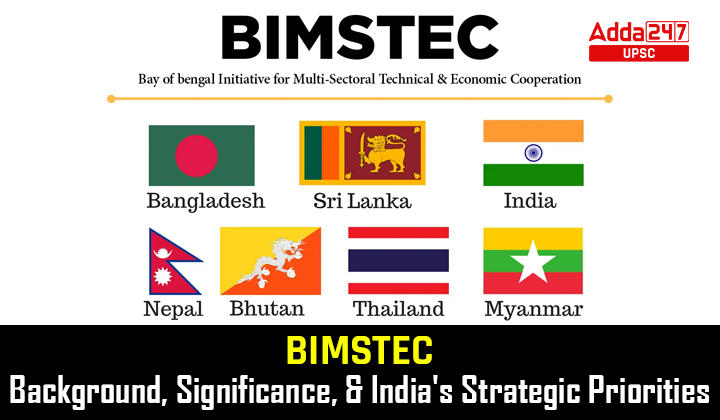Table of Contents
BIMSTEC: Fostering Regional Cooperation and India’s Strategic Priorities
Relevance: GS-2- Bilateral, regional, and global groupings and agreements involving India and/or affecting India’s interests.
Context:
The first-ever Foreign Ministers’ meeting of the Bay of Bengal Initiative for Multi-Sectoral Technical and Economic Cooperation (BIMSTEC) took place in Bangkok, Thailand, on July 17. The meeting was attended by India’s External Affairs Minister S Jaishankar, who highlighted the areas of coordination
challenges discussed, including health and energy security.
BIMSTEC Background:
- BIMSTEC, originally known as BIST-EC (Bangladesh-India-Sri Lanka-Thailand Economic Cooperation), was formed with the aim of fostering economic and technical cooperation among member nations.
- Over time, the organization expanded its membership to include Myanmar in 1997 and Bhutan and Nepal in 2004.
Member Countries and Economic Significance:
- The Bay of Bengal Initiative for Multi-Sectoral Technical and Economic Cooperation (BIMSTEC) is a regional organization that was established on 06 June 1997 with the signing of the Bangkok Declaration.
- Members of this regional unity are located along the littoral and in nearby areas of the Bay of Bengal.
- Five of the group’s seven members are from South Asia – Bangladesh, Bhutan, India, Nepal, and Sri Lanka in South Asia.
- Myanmar and Thailand are two from Southeast Asia.
- BIMSTEC links not just South and Southeast Asia but also the Great Himalayan and Bay of Bengal ecologies.
- Its primary goals are to foster cooperation on issues of regional importance, accelerate social advancement, and create an atmosphere that is conducive to rapid economic development.
- The seven BIMSTEC countries represent around 22% of the world’s population and have a combined GDP of close to $2.7 trillion.
- The Bay of Bengal region sees a significant flow of trade, with a quarter of the world’s traded goods crossing its waters annually.
Evolution of Cooperation within BIMSTEC:
- Initially, BIMSTEC focused on six sectors: trade, technology, energy, transport, tourism, and fisheries.
- In 2008, the organization expanded its scope to include other areas of cooperation.
- In 2021, a reorganization led to each member state taking the lead in specific sectors.
- India, as the largest economy in the region, focuses on security, counter-terrorism, transnational crime, disaster management, and energy.
India’s Push for BIMSTEC’s Revitalization:
- Although BIMSTEC has existed for several years, it gained renewed attention when India actively promoted it in October 2016, following a terrorist attack in Uri.
- India hosted an outreach summit with BIMSTEC leaders alongside the BRICS summit in Goa.
- Prior to that, some BIMSTEC countries had supported India’s call to boycott the South Asian Association of Regional Cooperation (SAARC) summit in Islamabad.
- India considered the postponement of the SAARC summit as a victory in isolating Pakistan.
Strategic Incentives for BIMSTEC Member Countries:
- Each BIMSTEC member country has strategic incentives to promote the organization’s growth. For example, Bangladesh sees BIMSTEC as a platform to establish itself beyond being a small state on the Bay of Bengal.
- Sri Lanka views it as an opportunity to connect with Southeast Asia and become a hub for the wider Indo-Pacific region.
- Nepal and Bhutan aim to enhance their connectivity with the Bay of Bengal and escape their landlocked positions.
- Myanmar and Thailand seek deeper connections with India to access its rising consumer market and balance China’s influence in Southeast Asia.
Significance for India’s Foreign Policy Priorities:
- For India, BIMSTEC holds significant importance. Indian Prime Minister emphasized that BIMSTEC connects South and Southeast Asia and serves as a common space for peace and development.
- It aligns with India’s foreign policy priorities of “Neighbourhood First” and “Act East.”
- Additionally, the Bay of Bengal’s strategic location is crucial for China, and BIMSTEC provides India an opportunity to counter Chinese investments and advocate for connectivity projects based on recognized international norms.
Establishing Codes of Conduct and Peaceful Cooperation:
- BIMSTEC also presents an opportunity to establish codes of conduct that preserve freedom of navigation and maintain peace in the region, contrasting China’s behavior in the South China Sea.
- Furthermore, BIMSTEC, being an inter-regional organization connecting South Asia and ASEAN, differs from SAARC, which is purely regional. While the SAARC summit has been postponed, there remains a possibility of its revival.
Conclusion:
The first-ever Foreign Ministers’ meeting of BIMSTEC marks an important milestone for the organization. BIMSTEC has gradually gained prominence, and India has played a crucial role in revitalizing it. BIMSTEC holds immense potential for regional development and peace. Moreover, for India, BIMSTEC offers a
platform to address coordination challenges and promote its key foreign policy priorities in the Bay of Bengal region, while countering Chinese influence and advocating for connectivity projects based on international norms.
| Follow US | |
| UPSC Govt. Jobs UPSC Current Affairs UPSC Judiciary PCS Download Adda 247 App here to get the latest updates |



 TSPSC Group 1 Question Paper 2024, Downl...
TSPSC Group 1 Question Paper 2024, Downl...
 TSPSC Group 1 Answer key 2024 Out, Downl...
TSPSC Group 1 Answer key 2024 Out, Downl...
 UPSC Prelims 2024 Question Paper, Downlo...
UPSC Prelims 2024 Question Paper, Downlo...
